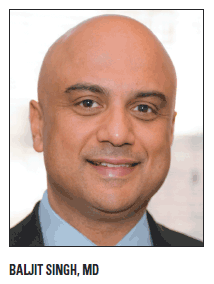Breast tissue evaluation with fine-needle aspiration fast tracks cancer Rx planning
In the past decade, core biopsy has largely replaced fine-needle aspiration for breast tissue evaluation. The latter technique’s inability to distinguish between invasive cancer and in situ cases and a general unease among pathologists not trained in cytopathology (in interpreting cells rather than tissue) are two of the main reasons that FNA has fallen out of favor (Diagnostic Cytopathology online, November 19, 2008).
ABSTRACT: Despite its limitations, FNA offers lower cost, less invasion, and fewer complications. Experts discuss why they chose FNA over core biopsy.
In the past decade, core biopsy has largely replaced fine-needle aspiration for breast tissue evaluation. The latter technique’s inability to distinguish between invasive cancer and in situ cases and a general unease among pathologists not trained in cytopathology (in interpreting cells rather than tissue) are two of the main reasons that FNA has fallen out of favor (Diagnostic Cytopathology online, November 19, 2008).

At the same time, FNA is less costly, less invasive, and produces fewer complications. It’s an easier procedure for patients, and it produces results for clinicians more rapidly. These facts have prompted some cancer centers to continue to rely on FNA, especially in cases where tumors are small and palpable, while recognizing the diagnostic method’s limitations.
“The benefits of FNA are that it is easier for the patient, and it produces less pain and less trauma to the breast. The risk of infection is also higher with core biopsy,” said Britt-Marie Ljung, MD, professor of pathology at the University of California, San Francisco, and codirector of the UCSF division of cytopathology.
“If a cytopathologist or pathologist is present at the biopsy, results from an FNA can be available almost immediately, and certainly the same day as the procedure,” Dr. Ljung said. A core biopsy, however, usually requires at least two days for a definitive diagnosis.
In a multidisciplinary team setting, where results can be immediately communicated to a woman’s healthcare team (oncologist, radiologist, surgeon), an FNA diagnosis can mean that treatment planning begins right away, according to Dr. Ljung, who discussed FNA at the 2008 Breast Imaging and Cancer: Multidisciplinary Approach to Breast Cancer Symposium hosted by UCSF.
Faster treatment planning can help reduce worry for patients and streamline medical care, especially in cases that meet the triple test: Clinical, radiographic, and pathology results are concordant.
“For breast cancer, the benefits of FNA are that it is a fast and reliable method,” said medical oncologist Pamela Munster, MD, an associate professor at UCSF and director of early phase clinical trials. “In some situations, core biopsy is not needed.”

While the accuracy of results from core biopsy and FNA are both operator-dependent, the training and expertise of the clinician performing FNA is of special concern, according to Dr. Ljung. Th e presence of a pathologist or cytopathologist reduces the number of insufficient samples and improves accuracy of results. At UCSF, where cytopathologists are closely involved in FNA diagnosis, the false-negative rate is only 2%, Dr. Ljung said.
However, studies of FNA in other settings have found sensitivities that range from 43.8% to 95%, while specific cities ranged from 89.8% to 100%, according to the Diagnostic Cytopathology article. By contrast, studies have found that sensitivities for core biopsy ranged from 94% to 99%, and specific cities from 99% to 100%.
When is FNA most appropriate?
Oncologist Yelena Novik, MD, an assistant professor of medicine at the New York University Cancer Institute, noted that when a woman has a small palpable breast cancer, FNA is an entirely reasonable choice. In these cases, because the tumor is palpable, there’s usually little question of whether it is invasive. “It’s a double win: The patient gets a procedure that’s less painful and less invasive, and the surgeon gets the most important information rapidly,” she said.
Yet in cases where in situ disease is suspected, core biopsy would be preferred. The same is true for cases in which a woman presents with a larger palpable lump. In these cases, it’s possible that the patient will need neoadjuvant therapy before surgery, such as chemotherapy or hormonal therapy. Her breast tissue needs to be tested for estrogen and progesterone receptors as well as HER2 status in order to choose the best treatment. “In these cases, a core biopsy is in the best interest of the patient because it gets a bigger piece of tissue and the pathologist has more material to work with,” Dr. Novick said.

“The biggest shortcoming of FNA is biological and not anatomical,” explained Baljit Singh, MD, director of breast pathology at NYU. “Treatment options today are essentially a function of a tumor’s receptor status, and all these are assessed by immunohistochemical stains on invasive cancer. While immunohistochemical stains can be done on FNA smears, the techniques are not developed or standardized at most labs, including commercial labs.”
However, Dr. Ljung explained that if cell blocks are prepared from FNA material, which is routinely done at UCSF, receptor and HER2-neu status can be assessed with routine techniques standardized for histopathology specimens.
Dr. Singh emphasized that it’s important that FNA be done when it’s appropriate and in a multidisciplinary setting, where the triple test can easily be applied. If the clinical, radiological, and pathological exams all agree, there’s little question about a woman’s treatment aft er FNA of a small palpable mass. Yet if the triple test is discordant, a more invasive procedure is usually necessary. “With a multidisciplinary team that applies the triple test, there’s much less risk of a false diagnosis,” Dr. Singh said.

Fine-needle aspiration for soft-tissue metastases
At the same time, FNA can also be a good choice for metastatic disease in patients with breast cancer, according to Dr. Ljung. “FNA is very effective in sampling suspicious masses in the supraclavicular neck and axillary area, in addition to local recurrence in the breast and chest wall and some distant body sites,” she said. John W. Park, MD, associate professor of medicine and attending medical oncologist at the University of California, San Francisco, noted that there’s been an increasing trend to use FNA when breast cancer has metastasized to the lung, liver, and other soft -tissue sites. But that’s not a hard and fast rule. Whether FNA is used is dependent on the site as well as clinical and radiographic findings about the tumor, he said.
FNA does not usually require sophisticated equipment or image guidance and is thus less costly. Because a smaller needle is used, it causes less trauma to the breast and is an obvious benefit for patients-especially when their tumors are small or look like they may be cysts. Dr. Ljung noted that 80% to 90% of all breast lumps are benign, so FNA can be a good choice when there’s reason to suspect no malignancy. In these cases, FNA can provide a speedier answer for a woman undergoing biopsy, and an easier recovery. “And if the woman has to undergo another biopsy down the line, she is less likely to be fearful about it,” she said.
In the end, however, whether an FNA is used for breast biopsy is a matter of performing a cost-benefit analysis. Which type of biopsy is more likely to serve the patient and improve outcomes? “It’s a more patient-friendly procedure, and thus has some advantages, but it’s not necessarily appropriate in all cases,” Dr. Park said.
Newsletter
Stay up to date on recent advances in the multidisciplinary approach to cancer.
Elevating the Quality of Cancer Care via Cross-Department Collaboration
Experts from Sibley Memorial Hospital discuss how multidisciplinary work has enhanced outcomes such as survival and resource use at their institution.